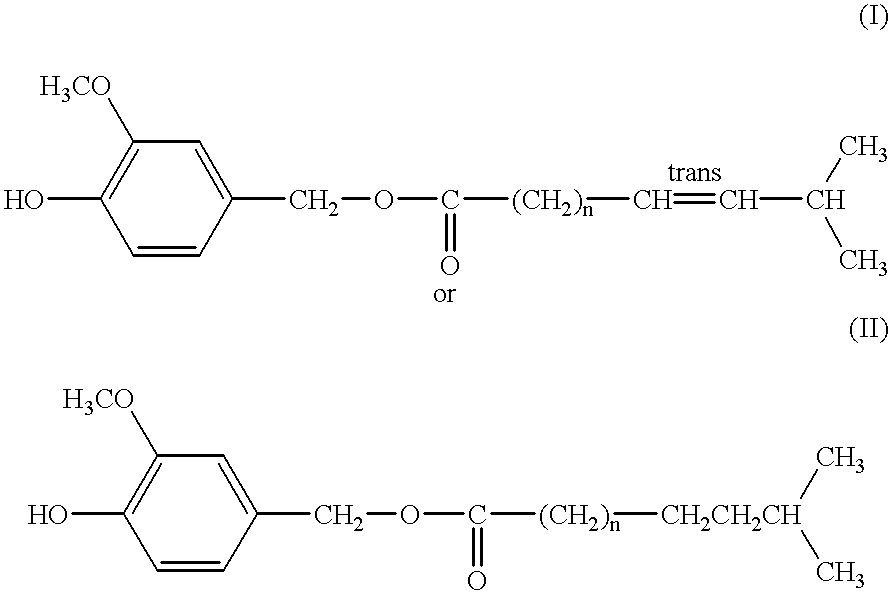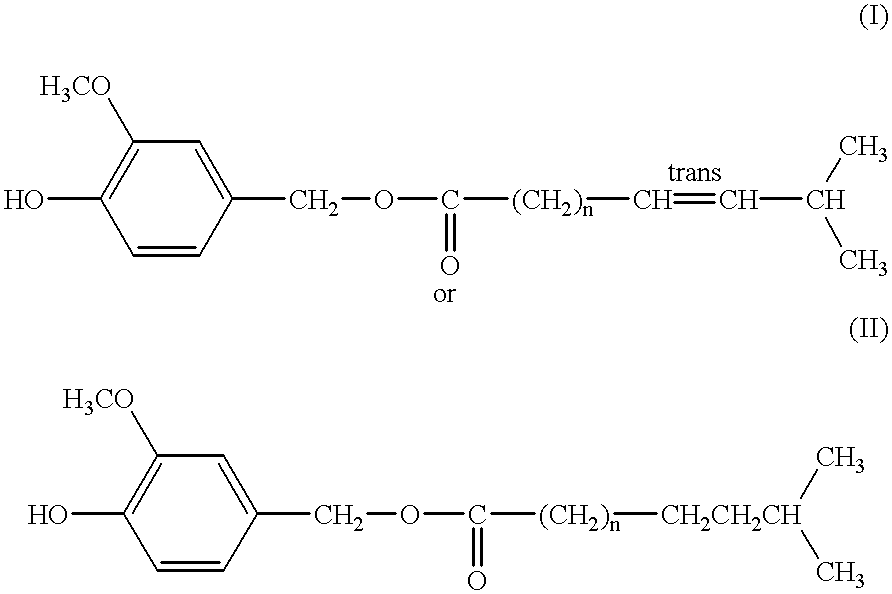Capsaicinoide-like substances having ester bond
a technology of capsaicinoide and ester bond, which is applied in the direction of biocide, plant/algae/fungi/lichens ingredients, food preparation, etc., can solve the problems of considerable limitation in its use as food additive or drug
- Summary
- Abstract
- Description
- Claims
- Application Information
AI Technical Summary
Benefits of technology
Problems solved by technology
Method used
Image
Examples
example
Example 1
Isolation and Purification of the Present Capsaicinoid-like Substances
After fresh fruits (1.00 kg) of CH-19 sweet had been freeze-dried, their seeds and calyces were removed, and the residue was extracted with 1.8 L each of ethylacetate three times by use of a Universal Homogenizer (Nihon Seiki Seisakusho, Japan). The ethylacetate extract was evaporated under reduced pressure to distill out ethylacetate and to afford an oleoresin (7.3 g). The oleoresin was chromatographed on silica gel (Silica gel 60 Merck; 36.times.200 mm) with stepwise elution of n-hexane and ethylacetate. The fraction eluted with ethylacetate was rechromatographed on reversed phase silica gel (Wakosil 25C18 of Wako Pure Chem. Co. Ltd. (Japan): 20.times.50 mm) with 75% MeOH eluent to afford Compound 3 (4.5 mg)
On the other hand, the fraction eluted with n-hexane / ethylacetate (80:20) was rechromatographed on reversed phase silica gel (Wakosil 25C18 of Wako Pure Chem. Co. Ltd. (Japan); 20.times.90 mm) with 7...
example 2
Structural Determination of the Present Capsaicinoid-like Substances
Spectroscopic analyses of the present compounds were performed with the following apparatuses.
.sup.1 H-NMR (399.65 MHz, CDCl.sub.3) and .sup.13 C-NMR (100.40 MHz, CDCl.sub.3) spectra (TMS as an internal standard) were recorded on a JEOL alpha-400 instrument. IR spectra were recorded on a Hitachi 270-50 infrared spectrophotometer, and UV spectra were recorded on a Jasco UVIDEC 660 spectrophotometer. HRMS spectra were recorded on a JEOL JMS-700 apparatus.
Identification of Compound 1
Spectral data of Compound 1 obtained with the above analytical means were as follows.
HRMS m / z z(M.sup.+): Calcd. (C.sub.18 H.sub.26 O.sub.4): 306.1831 Found: 306.1798.
IR .nu..sub.max (film) cm.sup.-1 : 3450, 1740, 1615, 1610, 1520, 1470, 1435, 1275, 1160, 1120, 1035, 970, 850, 815, 795, 560.
UV.sub.max (MeOH) nm: 280 (.epsilon.: 2400), 231 (.epsilon.: 6200).
.sup.1 H-NMR and .sup.13 C-NMR spectra:
These data are shown in Tables 1 and 2 below, ...
example 3
Immunopotentiating Activity of the Present Capsaicinoid-like Substances
The immunopotentiating activity of the present capsaicinoid-like substances was examined by observing their effect on the antibody production of hybridomas.
The present capsaicinoid-like substances obtained in Example 1 (20.5 mg) was mixed with ethyl acetate (66 .mu.l) to give 1N solution. The resulting solution (8 .mu.l)was resolved into a serum-free ITES ERDF medium containing insulin (5 .mu.g / ml), transferrin (35 .mu.g / ml), ethanol amino (20 .mu.M) and selenium (2.5 nM) to give 200 .mu.M solution. By using this solution, culture media containing the present capsaicinoid-like substances in various concentrations were prepared, and the following hybridomas were cultured in these media. A culture medium containing capsaicin was used as a control.
The results shown in FIG. 1, FIG. 2 and FIG. 3 demonstrate that the capsaicinoid-like substances (designaed as "CLS-B" in the figures) increased the production of IgM and ...
PUM
| Property | Measurement | Unit |
|---|---|---|
| temperature | aaaaa | aaaaa |
| temperature | aaaaa | aaaaa |
| size | aaaaa | aaaaa |
Abstract
Description
Claims
Application Information
 Login to View More
Login to View More - R&D
- Intellectual Property
- Life Sciences
- Materials
- Tech Scout
- Unparalleled Data Quality
- Higher Quality Content
- 60% Fewer Hallucinations
Browse by: Latest US Patents, China's latest patents, Technical Efficacy Thesaurus, Application Domain, Technology Topic, Popular Technical Reports.
© 2025 PatSnap. All rights reserved.Legal|Privacy policy|Modern Slavery Act Transparency Statement|Sitemap|About US| Contact US: help@patsnap.com



